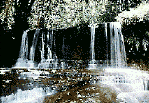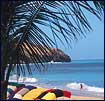| Lambir National Park
Ecologists know Lambir Hills is the world's most ecologically diverse area. Just a sample 52 hectares of the park's 7,000 hectares revealed 1,050 different species of tree, and each tree supports.1,000 species of insect life. Ecologists think there are many plant and insect species in the park waiting to be discovered. |
|
|
Its forest is home to gibbons, tarsiers, bearded pigs, flying squirrels, deer and 157 types of bird. You will see the wildlife as you wander the park's forest trails. The longest and toughest is to the top of Bukit Lambir (465 metres) but the superb views of the rainforest below make the climb worth it. |
| There is a 40 metre tall tree tower on the trail from which you can get a close up view of the pullulating life of the rainforest canopy and it is ideal for bird watching. Lambir is one of the most accessible of Sarawak's national parks, just a 30 minute drive from Miri, making the park ideal for a day visit. But, if you want to study the wildlife at leisure, there is overnight accommodation at the park headquarters. |
|
Loagan Bunut
|
|
The incredible shrinking lake is the centre piece of this park. Sarawak's biggest lake, called Loagan Bunut by the local Berawan people, is the State's largest natural lake, covering 650 hectares. But in dry months, usually February and May or June, the lake shrinks to nothing and you can walk on great expanses of dry mud flats. . |
| Over the centuries, the Berawan have developed their own method of fishing called selambau. In the months of February to June, the lake's water level drops drastically and is exceptionally spectacular to witness the Selambau fishing carried out during this time. The whole lake becomes a vast expanse of dry cracked mud, in which they literally scoop up the migrating fish as the water levels change. No matter what the water level, the lake and its surroundings provide fascinating scenery and are vibrant with forest life. |
| The park is an ideal spot for bird watchers. The lake and surrounding peat forests abound with large birds such as darters, egrets, herons, bitterns, hornbills, and kites as well as a host of smaller birds. |
|
| The morning cacophony of gibbons attests to the rich animal life that inhabits the park. The Stork-billed kingfisher, the largest of Borneo's eleven kingfisher species. |
Tours
 - SARAWAK - History & People Kuching I Kuching II Other Places Adventure Wildlife Sanctuaries National Parks |
|




